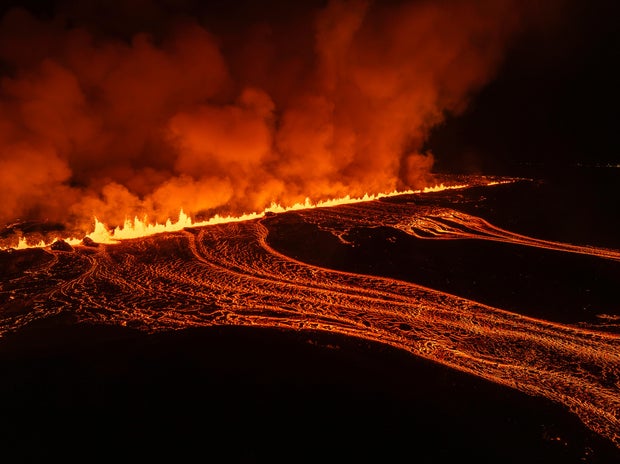A volcano on the Reykjanes peninsula in Iceland flared again late Wednesday night, marking the region’s seventh eruption in just one year.
Lava burst from a crack in the ground before midnight local time, originating in a spot where there has been a resurgence of volcanic activity. It happened quickly and sent a molten stream traveling toward the Blue Lagoon, Iceland’s most famous tourist attraction. It’s a geothermal spa set in a lava field just outside the town of Grindavík that draws nearly a million visitors each year.
Tourists were evacuated from the Blue Lagoon, Iceland’s national broadcaster RÚV reported. Some can be seen venturing startlingly close to the magma, in an apparent effort to capture the eruption on their phones, in a video published by the broadcaster. Response crews ushered them to safety before the magma roiled farther over the area, covering a section of the parking lot adjacent to the Blue Lagoon as well as a critical pipeline that funnels hot water from a geothermal power station, called Svartsengi, into the spa and around the peninsula.
Striking aerial footage of the situation also published by RÚV showed the expanse of the eruption. Fiery magma blankets the ground in the video, and thick smoke rises from it into the air.
People were evacuated from about 50 homes Wednesday in Grindavík, a small fishing town on Iceland’s southern peninsula, according to the country’s Civil Protection Agency. The agency said it was unclear exactly which volcano was erupting, but noted the lava came from the same area experiencing volcanic activity. Grindavík is some 30 miles south of Reykjavík, Iceland’s capital city. Icelandic officials have not reported issues in the capital caused by the eruption.
Civil Protection in Iceland via AP
Officials said Thursday that volcanic activity was ongoing, with seismic monitors indicating the magma had spread over at least 7 square kilometers of land, slightly less than 4 1/2 square miles. The Njarðvík pipeline could still function Thursday beneath the magma, said the Icelandic Meteorological Office. Magma had crossed the road into Grindavík when the office shared its most recent update, but the eruption’s peak had seemingly passed by then and the fissure from which it originated had shortened, according to measurements taken by the National Police Commissioner’s special forces unit.
Earthquakes in the area caused the ground to split and triggered the volcano, the office said. Iceland is situated on top of a rift between two tectonic plates, which makes the island nation vulnerable to earthquakes and volcanic eruptions, which have rocked portions of the country and displaced residents in recent years.
Marco di Marco / AP
It was the seventh time Iceland’s Reykjanes peninsula experienced a volcanic eruption since December 2023, with multiple previous flares breaking out over the summer. Officials said the latest eruption was less severe than the last one, which happened in August and resulted in multiple ground fissures as well as a subsequent 4.1-magnitude earthquake. The August incident came just two months after an eruption continued spewing lava for more than three weeks.
At the time, a regional police chief told Icelandic media that most of Grindavík’s 4,000 residents had evacuated from their homes the prior November when the spell of volcanic activity started to kick up. While some had returned part-time to the town, few were comfortable staying overnight, the police chief said. Those who had returned were successfully evacuated.
Before the Mount Fagradalsfjall eruption in March 2021, the Reykjanes peninsula had not seen volcanic activity in roughly 800 years. Since then, seismologists have carefully observed the reawakening of a long-dormant fault line running under the landscape.



Leave a Reply